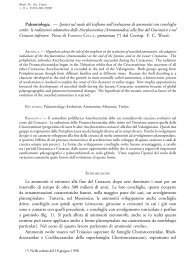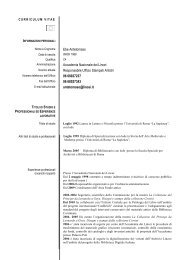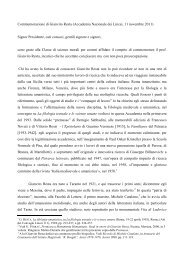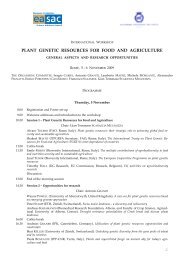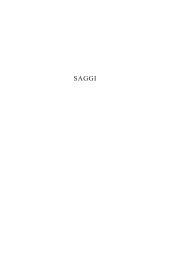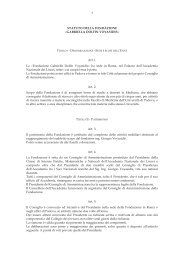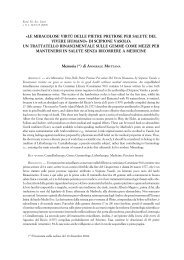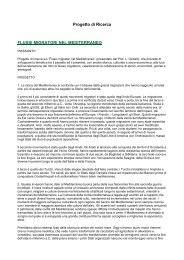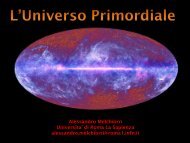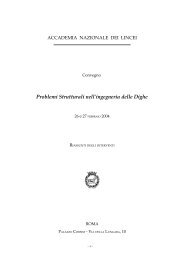Bollettino dei Classici - Accademia Nazionale dei Lincei
Bollettino dei Classici - Accademia Nazionale dei Lincei
Bollettino dei Classici - Accademia Nazionale dei Lincei
Create successful ePaper yourself
Turn your PDF publications into a flip-book with our unique Google optimized e-Paper software.
<strong>Accademia</strong> <strong>Nazionale</strong> <strong>dei</strong> <strong>Lincei</strong><br />
Comitato per la preparazione dell’Edizione nazionale <strong>dei</strong> <strong>Classici</strong> greci e latini<br />
Il Comitato è stato istituito con Regio Decreto del 3 aprile 1928, e di nuovo istituito con Decreto<br />
del Capo Provvisorio dello Stato del 18 maggio 1947, come organo di alta consulenza scientifica<br />
presso l’<strong>Accademia</strong> <strong>Nazionale</strong> <strong>dei</strong> <strong>Lincei</strong>.<br />
Il Comitato è costituito, per legge, da 7 Membri Accademici <strong>dei</strong> <strong>Lincei</strong>, dal Presidente<br />
dell’Istituto Italiano per la Storia antica, da 2 Membri, in qualità di esperti, designati per<br />
particolari capacità scientifiche e nominati con Decreto del Presidente della Repubblica o con<br />
Decreto del Ministero per i Beni e le Attività Culturali.<br />
Prerogativa del Comitato è l’assegnazione e la revisione scientifica <strong>dei</strong> volumi dell’Edizione<br />
<strong>Nazionale</strong> <strong>dei</strong> <strong>Classici</strong> greci e latini, pubblicati dall’Istituto Poligrafico dello Stato; inoltre il<br />
Comitato ha la responsabilità scientifica della pubblicazione periodica “<strong>Bollettino</strong> <strong>dei</strong> <strong>Classici</strong>” e<br />
<strong>dei</strong> relativi Supplementi.<br />
I. “<strong>Bollettino</strong> <strong>dei</strong> <strong>Classici</strong>”<br />
Dal 1928 al 1939 i contributi scientifici approvati dal Comitato sono stati pubblicati nei<br />
“Rendiconti della Classe di Scienze Morali” dell’<strong>Accademia</strong>.<br />
Nel 1940, 1941, 1942 sono stati pubblicati nr. 3 fascicoli del “<strong>Bollettino</strong> del Comitato” (I serie),<br />
come supplementi ai “Rendiconti della Classe di Scienze Morali” dell’<strong>Accademia</strong>, serie VII,<br />
voll. I-III (con abbreviazione dell’Année Philologique: “BPEC” = “<strong>Bollettino</strong> del Comitato per<br />
la preparazione dell’edizione nazionale <strong>dei</strong> classici greci e latini”).<br />
Dal 1945 al 1979 sono stati pubblicati nr. 27 fascicoli del “<strong>Bollettino</strong> del Comitato” (Nuova<br />
serie, con abbreviazione dell’Année Philologique: “BPEC”= “<strong>Bollettino</strong> del Comitato per la<br />
preparazione dell’edizione nazionale <strong>dei</strong> classici greci e latini”), che raccolgono contributi in<br />
lingua italiana ed in lingue straniere, relativi alla storia della tradizione, alla critica del testo,<br />
all’ecdotica, all’esegesi di testi greci e latini.<br />
Dal 1980 al 2010, con la variazione del nome della Rivista, sono stati pubblicati nr. 31 fascicoli<br />
del “<strong>Bollettino</strong> <strong>dei</strong> <strong>Classici</strong>” (Serie terza, con abbreviazione dell’Année Philologique:<br />
“BollClass”), che raccolgono contributi in lingua italiana ed in lingue straniere, relativi alla storia<br />
della tradizione, alla critica del testo, all’ecdotica, all’esegesi di testi greci e latini.<br />
L’indice <strong>dei</strong> fascicoli, editi dal 1940 al 1979, è pubblicato in “<strong>Bollettino</strong> del Comitato”<br />
(“BPEC”) Nuova serie XXVII (1979); quello relativo ai fascicoli editi dal 1980 al 1991 è<br />
pubblicato in “<strong>Bollettino</strong> <strong>dei</strong> <strong>Classici</strong>” (“BollClass”) Serie terza XII 1991; quello relativo ai<br />
fascicoli editi dal 1992 al 1999 è pubblicato in “<strong>Bollettino</strong> <strong>dei</strong> <strong>Classici</strong>” (“BollClass) Serie terza<br />
XXI (2000), insieme con l’indice con l’indice generale <strong>dei</strong> fascicoli editi dal 1940 al 1999;<br />
quello relativo ai fascicoli editi dal 2000 al 2009 è pubblicato in “<strong>Bollettino</strong> <strong>dei</strong> <strong>Classici</strong>”<br />
(“BollClass) Serie terza XXX (2009).<br />
N.B. Alla fine di queste pagine sono raccolti i dati seguenti: 1. notizie bibliotecniche relative<br />
alla pubblicazione; 2. indici e abstract di ciascun contributo pubblicato a partire dal<br />
fascicolo XXX (2009).
2<br />
Indice <strong>dei</strong> fascicoli editi dal 2000 al 2009<br />
Serie terza – Fascicolo XXI (2000)<br />
F. Pontani, Il proemio al Commento all’Odissea di Eustazio di Tessalonica………………………..………Pag. 5<br />
M. Menchelli, Il Tol. 101/16 tra prima e terza famiglia della tradizione dionea……………………………. “ 59<br />
G. Morelli, Note testuali ai grammatici latini………………………………………………………………….“ 95<br />
L. Munzi, Per il testo <strong>dei</strong> grammatici latini……………………………………………………. ….………….“ 103<br />
A. Dell’Era, Ps 73 (72), 23-28………………………………………………………………………..……… “ 115<br />
Nota della Redazione…………………………………………………………………………………..………. ” 119<br />
Indice <strong>dei</strong> fascicoli (1940-1942; 1945-1979; 1980-1999; Supplementi)……………………………...…………”121<br />
Serie terza – Fascicolo XXII (2001)<br />
M. Manfredini, Un testimone trascurato dell’Anabasi di Arriano. Contributo alla revisione della tradi-<br />
zione manoscritta………………………………………………………………. ………………….……Pag. 3<br />
L. Galligani, Il Laurenziano Conventi Soppressi 207 di Erodoto e le sue particolarità linguistiche…..………” 27<br />
F. De Nicola, Sulla tradizione manoscritta del De utroque genere foeminarum di Pediasimo………………….." 95<br />
Nota della Redazione……………………………………………………………………………………..…….” 109<br />
Serie terza – Fascicolo XXIII (2002)<br />
G.B. Alberti, Noterelle erodotee……………………………………………………………………………..Pag. 3<br />
R. Cantore, Citazioni erodotee nei commentari omerici di Eustazio…………………….. ………………… “ 9<br />
G. De Gregorio, L’Erodoto di Palla Strozzi (cod. Vat. Urb. Gr. 88)………………………………………… “ 31<br />
Nota della Redazione……………………………………………………………………………. ……………“ 131<br />
Serie terza – Fascicolo XXIV (2003)<br />
M. Manfredini, Un ibrido immaginario fra i codici <strong>dei</strong> Moralia di Plutarco: Patav. Bibl. Univ. 560+Heid.<br />
Pal. Gr. 153………………………………………………………………………………………….……..Pag. 3<br />
M. Manfredini, L’Aldina <strong>dei</strong> Moralia e la Giuntina delle Vitae di Plutarco: la tradizione di Galba e Otho<br />
fra manoscritti e libri a stampa………………………………………………………………………………“ 13<br />
D. Arnesano, Il “Copista del Dioscoride”. Un anonimo salentino del secolo XIII………………..…………. “ 29<br />
B. Hemmerdinger, Notes de philologie…………………………………………………………...….……… “ 57<br />
C. Hemmerdinger, Remarques sur quelques questions……………………………………………………… “ 63<br />
L. Perilli, Note critico-testuali alla nuova edizione del cosiddetto “testamement filosofico” di Galeno (De<br />
propriis placitis, CMG V 3, 2, ed. V. Nutton)………………………………………………………….…..……" 69
C.M. Lucarini, Note critiche ai Paradoxographi Graeci…………………………………………………..….. “ 87<br />
M. Lazzeri, Imerio e la nascita imerese di Stesicoro (Noterelle di storia della tradizione e degli studi)…… “ 93<br />
M. D’Ambrosi, L’esametro accentuativo in Giorgio Pisida…………………………………………………” 105<br />
A. Dell’Era, Il Carme LXV di Catullo……………………………………………………………………….” 135<br />
Nota della Redazione………………………………………………………………………………………….” 139<br />
3<br />
Serie terza – Fascicolo XXV (2004)<br />
V. Lorusso, Il trattato pseudo galenico De urinis del Parisin. Suppl. gr. 634……………………………….Pag. 5<br />
A. Mecca, Studi sulla tradizione di Erodiano storico: il gruppo cretese……………………………………..." 45<br />
S. Martinelli Tempesta, Marginalia Plutarchea (A systematic inquiry about marginal notes in certain<br />
exemplaria of the 16 th century printed editions of Plutarch’s De tranquillitate animi: first results)……... ” 79<br />
G.B. Alberti, Puntualizzazioni tucididee………………………………………………………………………” 111<br />
G.A. Privitera, L’esordio della settima Nemea………………………………………………………………...”121<br />
Nota della Redazione………………………………………………………………………………………… “ 125<br />
Serie terza – Fascicolo XXVI (2005)<br />
D. Bianconi, Un doppio restauro tricliniano: il Libanio vat. gr. 83 tra Nicola e Demetrio………………….Pag. 3<br />
C. Schiano, Sulla tradizione del De febribus dello pseudo Alessandro di Afrodisia (con appunti sulla<br />
di Lascaris)…………………………………………………………………………………………………. ”39<br />
N. Bianchi, Per una nuova edizione dell’ eJrmhneiva eliodorea di Filippo filosofo………………..………… ”69<br />
G. D’Alessandro, Su alcune analisi colometriche degli Scholia Vetera a Pindaro………………..…………. ”75<br />
B. Hemmerdinger, Notes de philologie……………………………………………………………..…………”109<br />
B. Gentili, Pindarica………………………………………………………………………………...…………”113<br />
Nota della Redazione……………………………………………………………………………..……………”115<br />
Serie terza – Fascicolo XXVII (2006)<br />
P. Canart, Les “morceaux choisis” de Psellos du Vaticanus graecus 712………………………………..Pag. 3<br />
L. Ferroni, Per una nuova edizione dello Ione platonico: la discendenza del Marc.Gr. App. Class.<br />
IV 1 [T]…………………………………………………………………………………………..………...”15<br />
N. Bianchi, Nuovi frammenti del Contra Galileos di Giuliano (dalle omelie di Filagato da Cerami)…….…”89<br />
B. Hemmerdinger, Le Catalogue homérique des vaisseaux et la Crète (rétractation)…………………… “105<br />
Nota della Redazione……………………………………………………………………………………….. ”107
4<br />
Serie terza – Fascicolo XXVIII (2007)<br />
V. Citti, Aesch. Suppl. 1-39……………………………………………………………………….………..Pag. 3<br />
C. Miralles, Gli anapesti della parodo delle Supplici di Eschilo: una lettura………………………………” 29<br />
F. G. Giannachi, La colometria del palinsesto di Sofocle (Leid. B.P.G. 60 A)……………………………...” 53<br />
A. Tessier, Note agli Scolii metrici a Pindaro………………………………………………………………” 77<br />
L. Andreatta, In margine alle voci dochmius e docmov" del Nomenclator metricus…......................................” 89<br />
B. Hemmerdinger, L’inculpation de Socrate (Eschine, Contre Timarque, § 173)…......................................” 97<br />
Nota della Redazione…………………………………………………………………………………………..”99<br />
Serie terza – Fascicolo XXIX (2008)<br />
S. Amendola, Eschilo, Pers 713……………………………………………………………………………Pag. 3<br />
V. Citti, Eschilo, Suppl. 86-111……………………………………………………………….......................” 17<br />
L. Lomiento, Eschilo, Suppl. 335-467 (Studio sulla struttura lirica e drammaturgica)……….…………….” 35<br />
G. Pace, Eschilo, Pers. 637-638………………………………………………………………….…………..” 59<br />
P. Volpe Cacciatore, Eschilo, Pers. 681-693…………………………………………………………………” 71<br />
M. Taufer, Digitalizzazione <strong>dei</strong> mss. eschilei e A New Repertory of Conjectures on Aeschylus (NRCA).…” 83<br />
P. Degni, Il codice di Niceta (Laur. Pl. 74.7) tra recupero e uso: alcune osservazioni……………….…….” 91<br />
Nota della Redazione…………………………………………………………….…………………….……” 117<br />
Serie terza – Fascicolo XXX (2009)<br />
M. P. Pattoni, Il motivo del sogno profetico nelle Coefore di Eschilo: note testuali e interpretative……Pag. 3<br />
P. Tavonatti, Demetrio Triclinio tra le fonti di Franciscus Portus?………………………………………..” 25<br />
A. Perruccio, Due note all’Agamennone eschileo………………………………………………………...” 35<br />
F. Boschetti, Studio degli spazi semantici con strumenti informatici come metodo esplorativo per la<br />
valutazione di congetture………………………………………………………………………………...” 41<br />
A. Natale, Spigolature sull’Encomio a Policrate di Ibico (fr. S 151 Davies)………………………………..” 53<br />
F. M. Petrucci, Un equivoco filologico: il De partibus philosophiae dello Pseudo-Galeno, i Prolegomena<br />
philosophiae di Davide e il ms. Vaticano Greco 2253…………………………………………………….” 83<br />
Nota della Redazione…………………………………………………………………………………………." 97<br />
Appendice: Indice <strong>dei</strong> fascicoli Serie terza XXI (2000) – XXX (2009)……………………………………...” 99
5<br />
A partire dal 1978 sono state pubblicate nr. 25 monografie (Supplementi al "<strong>Bollettino</strong> <strong>dei</strong><br />
<strong>Classici</strong>”) di particolare interesse filologico e storico-letterario:<br />
Suppl. 1 (1078): V. Loi, Origini e caratteristiche della latinità cristiana (esaurito)<br />
Suppl. 2 (1979): C. Gallavotti, Metri e ritmi nelle iscrizioni greche (88-218-0784-3)<br />
Suppl. 3 (1979): B.M. Palumbo Stracca, La teoria antica degli asinarteti (88-218-0785-1)<br />
Suppl. 4 (1982): S.M. Medaglia, Note di esegesi archilochea (88-218-0786-X)<br />
Suppl. 5 (1982): F. Ferlauto, Il secondo proemio tucidideo e Senofonte (88-218-0787-8)<br />
Suppl. 6 (1988): A. Cellerini, Introduzione all’Etymologicum Gudianum (88-218-0788-6)<br />
Suppl. 7 (1990): C. Crimi, Michele Sincello. Per la restaurazione delle venerande e sacre immagini (88-218- 0789-<br />
4)<br />
Suppl. 8 (1990): A. Cataldi Palau, Catalogo <strong>dei</strong> manoscritti greci della Biblioteca Franzoniana (Genova), Urbani<br />
2-20 (88-218-0790-8)<br />
Suppl. 9 (1990): S. Boldrini, Note sulla tradizione manoscritta di Fedro (88-218-0791-6)<br />
Suppl. 10 (1991): F. Della Corte, Storia (e preistoria) del testo ausoniano (88-218-0792-4)<br />
Suppl. 11 (1991): F. Stok, Prolegomeni a una nuova edizione della Vita Vergilii di Svetonio-Donato (88-218-0793-<br />
2)<br />
Suppl. 12 (1991): A.R. Sodano, Le sentenze “pitagoriche” dello pseudo-Demofilo (88-218-0794-0)<br />
Suppl. 13 (1994): F. D’Aiuto, Tre canoni di Giovanni Mauropode in onore di santi militari (88-218-0795-9)<br />
Suppl. 14 (1995): G. Brugnoli-C. Santini, L’Additamentum Aldinum di Silio Italico (88-218-0796-7)<br />
Suppl. 15 (1995): S. Maleci, Il codice Barberinianus Graecus 70 dell’Etymologicum Gudianum (88-218-0797-5)<br />
Suppl. 16 (1996): R. Fusco, La vita premetafrastica di Paolo il Confessore (88-218-0798-3)<br />
Suppl. 17 (1996): A. Cataldi Palau, Catalogo <strong>dei</strong> manoscritti greci della Biblioteca Franzoniana (Genova), Urbani<br />
21-40 (88-218-0799-1)<br />
Suppl. 18 (1999): C. Gallavotti, Theocritea (88-218-0800-9)<br />
Suppl. 19 (1999): L. Cristante, Reposiani Concubitus Martis et Veneris (88-218-0841-6)<br />
Suppl. 20 (2001): M.L. Agati, Giovanni da Maglie, copista greco (88-218-0840-81)<br />
Suppl. 21/22 (2004): S. Beta, Il linguaggio nelle commedie di Aristofane (88-218-0913-7)<br />
Suppl. 23 (2005): E. Sciarra, La tradizione degli scholia iliadici in terra d’Otranto (88-218-0934-X)<br />
Suppl. 24 (2007): M.L. Agati, Catalogo <strong>dei</strong> manoscritti greci della Biblioteca dell’<strong>Accademia</strong> <strong>Nazionale</strong> <strong>dei</strong> <strong>Lincei</strong><br />
e Corsiniana (978-88-218-0975-0)<br />
Suppl. 25 (2009): M. Ambrosetti, Q. Claudio Quadrigario. Annali (978-88-218-1014-5).<br />
N.B. Alla fine di queste pagine saranno pubblicati i titoli <strong>dei</strong> volumi del Supplemento, ora<br />
programmati ed in preparazione, una volta editi.<br />
II. Volumi dell’Edizione <strong>Nazionale</strong> pubblicati, in preparazione, in assegnazione<br />
P. Vergilii Maronis opera, a cura di R. Sabbadini<br />
vol. I: Bucolica et Georgica (1931)<br />
vol. II: Aeneis (1931)<br />
Res Gestae Divi Augusti, a cura di C. Barini (1937)<br />
Titi Livi “ab urbe condita”, libri XLI-XLV, a cura di C. Giarratano (1938)<br />
Heliodori Aethiopica, a cura di A. Colonna (1938)<br />
L. Annaei Flori quae extant, a cura di E. Malcovati<br />
I edizione (1938)<br />
II edizione (1972)<br />
Tabulae Iguvinae, a cura di G. Devoto<br />
I edizione (1938)<br />
II edizione (1962)
Cornelii Taciti Historiae (libri I-V), a cura di C. Giarratano (1940)<br />
Cornelii Taciti “libri ab excessu Divi Augusti” (libri I-VI), a cura di M.L. De Gubernatis (1940)<br />
Synesii Cyrenensis Opuscula, a cura di N. Terzaghi (1944)<br />
Synesii Cyrenensis Hymni, a cura di N. Terzaghi (1949)<br />
Theocritus quique feruntur Bucolici Graeci, a cura di C. Gallavotti<br />
I edizione (1946)<br />
II edizione (1955)<br />
III edizione (1993)<br />
L. Annaei Senecae “ad Lucilium epistulae morales”, a cura di A. Beltrami<br />
vol. I (1949)<br />
vol. II (1949)<br />
Himerii Declamationes et Orationes, a cura di A. colonna (1951)<br />
Xenophontis Opuscula, a cura di G. Pierleoni (1954)<br />
Aristoxeni Elementa armonica, a cura di R. Da Rios (1955)<br />
Eunapii Vitae Sophistarum, a cura di G. Giangrande (1956)<br />
Strabonis Geograhica, a cura di F. Sbordone<br />
vol. I: libri I-II-III (1963)<br />
vol. II: libri IV-V-VI (1970)<br />
Thucydidis Historiae, a cura di G.B. Alberti<br />
vol. I: libri I-II (1972)<br />
vol. II: libri III-IV-V (1992)<br />
vol. III: VI-VII-VIII (2000)<br />
Panegyrici Latini, a cura di V. Paladini-P. Fedeli (1976)<br />
Synesii Cyrenensis Epistolae, a cura di A. Garzya (1979)<br />
Commentarius in Apocalypsin Sancti de Liebana, a cura di A. Romero Pose<br />
vol. I (1985)<br />
vol. II (1985)<br />
Lucani opera, a cura di R. Badalì (1992)<br />
Appendix Vergiliana, a cura di A. Salvatore, A. De Vivo, L. Nicastri, G. Polara (1997)<br />
Vitae Vergilianae antiquae, a cura di G. Brugnoli-F. Stok (1997)<br />
Galeni Pergameni peri; yuch'", a cura di G. Magnaldi (1999)<br />
Strabonis Geographica, a cura di F. Sbordone-S.M. Medaglia<br />
vol. III: libri VII-VIII-IX (2000)<br />
Strabonis Geographica<br />
vol. IV: libri X-XI: in assegnazione<br />
vol. V: libri XII-XIII: in assegnazione<br />
vol. VI: XIV-XV: in assegnazione<br />
vol. VII: XVI-XVII+indici: in assegnazione<br />
Senecae de clementia, a cura di G. Mazzoli (in preparazione)<br />
6
Aeschyli opera<br />
vol. I: Agamennone, a cura di E. Medda (in preparazione)<br />
vol. II: Coefore, a cura di L. Battezzato (in preparazione)<br />
vol. III: Eumenidi: in assegnazione<br />
vol. IV: Sette contro Tebe: in assegnazione<br />
vol. V: Persiani: in assegnazione<br />
vol. VI: Supplici: in assegnazione<br />
vol. VII: Prometeo: in assegnazione<br />
vol. VIII: Frammenti: in assegnazione.<br />
7<br />
***<br />
Indicazioni editoriali [da "<strong>Bollettino</strong> <strong>dei</strong> <strong>Classici</strong>" XXX (2009)]<br />
Comitato direttivo e scientifico: Bruno Gentili (presidente), Paul Canart, Guglielmo Cavallo,<br />
Giovanni Battista Conso, Andrea Giardina, Claudio Leonardi, Armando Petrucci, Cesare Questa,<br />
Manlio Simonetti, Silvio M. Medaglia (segretario).<br />
Direttore responsabile: Ada Baccari, Cancelliere dell’<strong>Accademia</strong> <strong>Nazionale</strong> <strong>dei</strong> <strong>Lincei</strong>.<br />
Redazione: Segreteria del Comitato; Ufficio Redazione dell’<strong>Accademia</strong> <strong>Nazionale</strong> <strong>dei</strong> <strong>Lincei</strong>.<br />
Autorizzazione (del Tribunale di Roma) nr. 18156 del 13 giugno 1980.<br />
ISSN: 0391-8270.<br />
Sito web: www.lincei.it (> le attività > commissioni> comitato per l’edizione nazionale <strong>dei</strong><br />
classici greci e latini).<br />
E-mail: classici@lincei.it /redazione@lincei.it<br />
Invio. I contributi proposti per la pubblicazione debbono essere inviati alla Segreteria del<br />
Comitato <strong>Classici</strong>, <strong>Accademia</strong> <strong>Nazionale</strong> <strong>dei</strong> <strong>Lincei</strong>, Via della Lungara, 10, 00165 Roma (in<br />
formato cartaceo e su supporto elettronico); il testo deve essere corredato di un ‘abstract’ in<br />
lingua inglese.<br />
Valutazione. La valutazione anonima <strong>dei</strong> contributi è affidata a membri del Comitato e a revisori<br />
esterni italiani e stranieri.<br />
Serie terza – Fascicolo XXX (2009)<br />
M. P. Pattoni, Il motivo del sogno profetico nelle Coefore di Eschilo: note testuali e interpretative……..Pag. 3<br />
P. Tavonatti, Demetrio Triclinio tra le fonti di Franciscus Portus?………………………………………….” 25<br />
A. Perruccio, Due note all’Agamennone eschileo………………………………………………………......” 35<br />
F. Boschetti, Studio degli spazi semantici con strumenti informatici come metodo esplorativo per la<br />
valutazione di congetture…………………………………………………………………………………..” 41<br />
A. Natale, Spigolature sull’Encomio a Policrate di Ibico (fr. S 151 Davies)………………………………..” 53
F. M. Petrucci, Un equivoco filologico: il De partibus philosophiae dello Pseudo-Galeno, i Prolegomena<br />
philosophiae di Davide e il ms. Vaticano Greco 2253……………………………………………………..” 83<br />
Nota della Redazione…………………………………………………………………………………………." 97<br />
Appendice: Indice <strong>dei</strong> fascicoli Serie terza XXI (2000) – XXX (2009)……………………………………... ” 99<br />
ABSTRACT<br />
8<br />
I. (M.P. Pattoni): In the codex Laurentianus Mediceus the paragraphos at Choeph. 929 assigns 928 to Clytemesrra<br />
and 929-930 to Orestes. However, the vast majority of recent editors - among whom Page, Garvie, Bowen, West<br />
and, Iately, Somrnerstein - folIows Scaligerus' proposal to assign also 929 to Clytemestra and maintain only 930, the<br />
final line of the stichomythia, as Orestes' eue. In fact, both the dramatic cornposition of this stichomythia, in<br />
comparison with other similar passages, and arguments regarding formal aspects lead to the concIusion that the<br />
solution transmitted by the manuscripts is correct.<br />
II. (P. Tavonatti): Franciscus Portus was a Cretan hurnanist of 16th century. He studied under Arsenius of<br />
Monembasia and then came to Italy, where he taught Greek language and literature in Modena and at the University<br />
of Ferrara. Persecuted in Venice because of his adhesion to Protestantism, he escaped in Switzerland and in Geneva<br />
he was elected Publicus professor of Greek at the loeal Academy by John Calvin hirnself. Portus was interested in<br />
many topics (Homer, Hesiod, Pindar, Aristoteles, Xenophon, Hellenistic poetry, rhetors and grammarians) and<br />
among them he studied Aeschylus too. His work on the first of great tragedians ìs represented by the ms. B.P.L.<br />
180, the first western commentary on alI survived plays by Aeschylus, based on Vettori-Estienne's edition, and the<br />
cod. 756 D 22, another exemplar of Vettori's edition who presents in the borders many conjectures and annotations.<br />
Both these autographs are conservcd in Leiden University Library. These works are only recently rediscovered by<br />
Mund-Dopchie and, after her, by M.L.West, who has adopted in his edition some conjectures of Portus.<br />
This artiele presents some conclusions from the analysis of B.P.L. 180 (subjeet of rny doetoral dissertation at the<br />
University of Trento): some variae lectiones, not attested in 16 th eentury editions, and scholia, unpublished at that<br />
time, put into perspectivc that a manuscript could be among Portus' sources far his work on Aeschylus. Many of<br />
these extravagantes forns are equivalent to tbe reading of the triclinian tradition (and T in partieular): this lets things<br />
(although there is no proof) that Portus could have known the work of the great byzantine scholar.<br />
III. (A. Perruccio): The paper argues for the manuscript tradition, so that no conjectures are needed in two<br />
Aeschylean passages. (a) Ag. 813-16 divka" ga;r oujk ajpo; glwvssh" qeoi; / kluvonte" ajndroqnh'ta" jIlivou<br />
fqora;" ej" aiJmathro;n teu'co" ouj dicorrovpw" / yhvfou" e[qento. In spite of Karsten's conjecture jIlioufqovrou"<br />
(adopt. Fraenke1), West and Sommerstein support Dobree's reading fqora'". The author suggests retaining the<br />
manuscript tradition: 1. the recall of Eur. Or. lO12 (West) does not appear appropriate; 2. the transmitted fqoravs<br />
gives acceptable sense in close predicative link to yhvfou" («evotes as acts I instances of destroying Troy»). (b) Ag.<br />
1196-97 ejkmartuvrhson proumovsa" to; m∆ eijdevnai / lovgwi pavlai tw'nd∆ aJmartiva" dovmwn. The emendation to;<br />
mh; eijdevnai recalls "a procedural device of the Athenian lawcourts", according to which a witness was required to<br />
swear on oath that he didn't know "the statement to be true" (Sommerstein). Nevertheless, a deeper insight into other<br />
passages, showing Cassandra asking the Chorus to witness for her being ajlhqovmanti" (vv. 1184-5; 1240-55),<br />
should confirm the reading to; mh; eivdevnai.<br />
IV. (F. Boschetti): This article studies the semantic spaces based on tbe lemmatized corpus of ancient Greek texts. A<br />
semantic space is a computational model based on the word distribution of a corpus, in order to represent semantic<br />
similarity by spatial proximity. Even if statistical methods cannot provide textual evidences, philologists can be<br />
assisted by explorative tools that suggest lists of words semantically related when they conceive or evaluate<br />
conjectures. In this study four semantic spaces have been generated. The first is based on the entire collection of<br />
Greek texts and the others are based on subcorpora: the Homeric poems, the corpus of the Greek tragedy with<br />
related scholia and the corpus of the philosophers. Each semantic space shows its peculiarities, strictly connected<br />
with the different genres. Semantic relations observed in the semantic spaces are distributed both on the syntagmatic<br />
and the paradigmatic axis: synonymy, hypernymy, holonymy, antonymy are the relations among the closest terms in<br />
lists of associations generated by the computational tools used to explore the semantic spaces. Finally, semantic<br />
spaces based on chronological subcorpora allow us to study terms that have preserved or changed their meanings,<br />
Keywords: synonymity, antonymy, semantic spaces, computational linguistics, lemmatized corpus.<br />
V. (A. Natale): The Polycrates commended in the poem discovered in P. Oxy. 1790 - Ibyc. fr. S 151 Dav. - is most<br />
probably the master of Sarnos when, still young and not yet a tyrant, he was the descendant of a wealthy and
9<br />
powerful family, who loved rnusic and poetry. Al the end of v. 46, toi'" me;n pevda kavlleo" aijevn, the punctuation<br />
mark of the papyrus should be kept, while intcrpreting pevda as a verbal form; an already ancient exegesis, this<br />
doesn't exclude the hypothesis of identification of the character here embraced. At v. 5 (xanqa'" JElevna" peri;<br />
ei[<strong>dei</strong>) an interpretation of the substantive eidos, with the generic meaning of image, appearance, is proposed, in<br />
opposition to the established renderìng, that refers il to the beauty of the heroine. This might induce us, albeit with a<br />
daring supposition, to detect in tbe verse an allusion to the well-known Stesichorean version of Helena's myth, who<br />
was taken away from Paris and replaced with an eidolon. The story must bave been known to the Samian audience,<br />
which Ibycus most likely addressed, because it was likely to have already been sung by Hesiod, a poet whose verses<br />
are recalled at any other point of the encomium to Polycrates.<br />
VI. (F.M. Petrucci): The pseudo-galenic work De partibus philosophiae (Laur, plut. 56, 15, 207r-224v) has<br />
astonishing textual parallels in the pravxei" 19 and 20 of David's Prolegomena philosophiae; nevertheless these two<br />
texts don't stem from an ancient common source, as believed. As a matter of fact, it is possible to discover most of<br />
pseudo-galenic work divergences from David's one in a manuscript of tbe Prolegomena philosophiae, the Vaticanus<br />
graecus 2253. The De partibus philosophìae must stem or have traditional proximity with that manuscript: it is not<br />
an ancient work and it has to be considered only as a document for the textual tradition of David's Prolegomena<br />
philosophiae.<br />
***<br />
Serie terza – Fascicolo XXXI (2010)<br />
V. Citti, Aesch. Suppl. 234ss……………………………………………………………………………… Pag. 5<br />
G. Pace, La colometria della sezione lirica della parodo <strong>dei</strong> Persiani (vv. 65-139)…………………………. " 35<br />
P. Volpe Cacciatore, Aesch. Pers. 730-736……………………. …………………………………………….. " 53<br />
S. Novelli, Aesch. Sept. 822-831 (gli anapesti 'dalle molte contese', fra guerra e filologia)………………… " 63<br />
F. G. Giannachi, Correzioni colometriche al I stasimo dell'Antigone nel Marc. Gr. Z 617 (=810)…………..." 85<br />
M. Lazzeri, Soph. fr. 582 R. (e Theodect. fr. 10, 2 Sn.-Kann.)……………………………………………...…"101<br />
T. Raiola, Una nota testuale al Commento ad Epidemie VI di Galeno (Gal. In Hipp. Epidemiarum VI<br />
comm. 304-305 W.-Pf.)……………………………………………………………………………………." 119<br />
Nota della Redazione……………………………………………………. ……………...……………………" 129<br />
ABSTRACT<br />
I. (V. Citti): Aesch. Suppl. 235: some suggestions for Bergk's kajmpukwvmasin; ib. 266 for Porson's mhnith; davkh; ib.<br />
276 for manuscript's form prosfuvsw lovgwi; ib. 282-83: manuscript's Kuvprio" carakthvr t∆ ejn gunaikeivoi"<br />
tuvpoi" / eijkw;" pevplhktai tektovnwn pro;" ajrsevnwn is perhaps right; in 284s. it is necessary to accept the<br />
conjectures ∆Indav", ajkouvw, iJppobavmoisin and ajstrabizouvsa"; 286: the manuscript's form h[ [ikasa must be kept; in<br />
291-310 the suggestion of Sandin, which propose to keep the manuscript order, despite the commonly endorsed<br />
alternatives; for the 296 the best solution may be to print between cruces †pallagmavtwn†; in 324 the manuscript's<br />
ajnsthvsa" (with West) must be kept; in 330 manuscript's thvnde fughvn and to; privn must be kept, and Robortello's<br />
metaptoiou'san for m.'s meta; ptoivousan is the best solution; in 337 Porto's old correction oi[oito must be kept; in<br />
344 koinono;" h\n must be kept following Di Benederto's ignorate suggestion.<br />
II. (G. Pace): This paper offers a collation of the colometry of the parodos of the Persae transmitted by the sixteen<br />
most important Aeschylean manuscripts. The colometry of codex M appears to be aImost always correct and<br />
coherent (only in two places there is divergence beetwen the strophe and the antistrophe); deviations from this<br />
colometry in other manuscripts are probably due to corruption. Manuscripts I A O N K Q Pd preserve, more than<br />
otbers, a eolometry close to that of M. The coIIation of the colometry gives some evidence for the relation between<br />
manuscripts of the same family. On the basis of the colometry of M the metrical structure of the parodos and its<br />
relationship with the semantic-syntactic level are investigated. The colometry of M is also compared with that of
10<br />
modern editors, who often join two or three cola of M together and in doing so sometimes overshadow metrical and<br />
textual symmetries.<br />
III. (P. Volpe Cacciatore): At Aesch. Pers. 732 the interpretation of oujdev ti" gevrwn is problematic; West and,<br />
recently, Garvie have opted for the cruces desperationis. I propose to keep the manuscript text, introducing a sign of<br />
aposiopesis after gevrwn to mark the sudden breaking off of tbe sentence at the end of the line: the queen's words are<br />
suddently stopped by Darius' following exclamation, which would explain the ellipsis of the verb. I think that the<br />
implied verb could be oi[cwke, with its double meaning of "to go away/to die", At 736 I accept Page's (and<br />
Garvie's) e}n duoi'n zeukthvrion, with the meaning, "one thing you yoking two".<br />
IV. (S. Novelli): The paper concerns the anapaestic clesis and is focused on assuming that the manuscript text and<br />
this ancient colometry are highly plausible. Retracing the exegetical history of the passage, the author discusses the<br />
main semantic and metrical problerns: specifical1y, at v. 822 megavle violates the Wifstrand's rule but is defended<br />
by perspicuous tragic parallels; at v. 826 ajsinei' is semantically congruous, as well as many poetic examples clearly<br />
attest in caivrw+living subjects (here swth'ri); at the same rime, ajtevknou" conforrns to the context and to<br />
Aeschylus' dramaturgic choices (v. 827); on the metric level, it is not neeessary to postulate a lacuna at vv. 824s.<br />
and 830, while the sequenee of four breves between dactylic and anapaestic metron at vv. 827s. is not total1y<br />
unusual in attic theatre; the variant attested in the Mediceus, rJuvesqe, and the break of synapheia at v. 824 are<br />
supported by v. 304 and some euripidean loci similes. These lexicaI, metrical and stylistic peculiarities are perfectly<br />
adequate to the aeschylean language and support the hypothesis that these anapaests were pronounced as lyrical<br />
verses and not as recitative ones.<br />
V. (F.G. Giannachi): This paper examines the manuscript tradition of the first stasimon of Sophocles' Antigones and<br />
in particular its layout in the ms. Marc. gr. Z 617 (=810) of the 14 th century, where are found some emendations to<br />
the metrical division of the cola. We try to recognize the author of the corrections and the time in which they are<br />
made, also comparing manuscript with its apograph for the Sophoclean text Pal. gr. 287.<br />
VI. (M. Lazzeri): In Soph. fr. 582 R., beIonging to the lost tragedy Tereus, some scholars (and the same Radt)<br />
reject the lectio sevla" and accept Bothe's emendation sevba". Neverthless, some observations (such as the<br />
occurrences between {Hlio" and sevla", some tragic examples - especially Aesch. Sept. 390-391, Soph. El. 17-18,<br />
Eur. El. 866 and Tr. 860 - and the comparison between Sophoc1es' fragment, Eur. Phoen. 3 and Theodect. fr. 10, 2<br />
Sn.-Kann.), suggest that the lectio sevla" should be quite legitimate, and can therefore be preserved.<br />
VII. (T. Raiola): This contribution deals with a textual problem in the greek tradition of Galen's Commentaria in<br />
Hìppocratis Epidemiarum librum VI (304, 13-306, 19 Wenkebach-Pfaff). With the support of the arabic translation<br />
of IXth century by Hunain ibn Ishaq, and considering Galen's usus scrìbendi, the author tries to reconstruct a better<br />
text, supposing the existence of a lacuna in the greek textual tradition of the Marcianus Venetus 283 manuscript,<br />
together with a significant interpolation due to an error made by the copyist.<br />
***<br />
Serie terza – Fascicolo XXXII (2011)<br />
M. T. Luzzatto, Commentare Demostene (Le strategie dell'hypomnema nel Didimo di Berlino)…….…… Pag. 3<br />
T. Raiola, Galeno, commento a Officina medici (Un nuovo incipit per il III libro)………………………..… " 73<br />
A. Tessier, Piccola storia di un accento euripideo: Oreste 140 e Dionigi di Alicarnasso, C. V. 11………... " 85<br />
P. Janni, L'aurora, il giorno e la notte (Testimonianze su luce e tenebre nella poesia e nella filosofia<br />
antiche)……………………………………………………………………………………………………. " 93<br />
P. D'Alessandro, Endecasillabi faleci e sistemi ionici nelle Menippee di Varrone (con un excursus su Laev.<br />
fr. 8 Blansdorf 2 )……………………………………………………………………………………………..………. " 131<br />
Nota della Redazione……………………………………………………. …………………………...………" 165<br />
ABSTRACT
11<br />
I. (M. T. Luzzatto): In this paper I argue, against generally held views, that PBerol.9780r. is a fragment from Book<br />
28 of Didymus's lucidly organized commentary on the whole corpus of Demosthenes, in its original format.<br />
Apparent gaps in the coverage of Philippics 10-13 are neither the result of excerption nor of negligence on the<br />
author's part, but reflect the re-use of the same topics and passages from one speech to another, which was a well-<br />
known feature of the Philippics. Didymus skips doublets (maybe following critical signs in his edition of the orator),<br />
and his very professional commentary obviously shrinks as it approaches the end. A detailed discussion of (a)<br />
Didymus fragments in Harpocration, (b) the order of speeches in ancient editions of Demosthenes, (c) the colophon<br />
in col. 15 demonstrates that PBerol. is the final part of Didymus's huge commentary on the orator, and refutes F.<br />
Leo's interpretation of the work as a historical syngramma about Demosthenes, casting serious doubts on the so-<br />
called Peri-literature as a whole.<br />
II. (T. Raiola): By the means of a reexamination of the manuscript tradition of the galenic commentary to<br />
Hippocrates' De Officina medici, this paper proposes to reconsider the incipit of the third book of the commentary<br />
itself, as it is printed in modern editions since the princeps. A strong evidence supporting the author's hypothesis is<br />
given by the arabic compendium of Ali ibn Ridwan, written in the XI th century A. D., whose third section starts with<br />
the same sentence recognised here as the real incipit of the third book.<br />
III. (A. Tessier): The first verse of the parodos of Euripides’ Orestes (140) is handed down to us in the ms. tradition<br />
with a slight variant reading, which nonetheless affects the metrical responsion of the strophe and has been therefore<br />
exposed to editorial assaults from the Paleologan age onwards. This paper aims to delve into the question, reexamining<br />
the different steps of the ecdotic practice on the tragic text: to this purpose new evidence is taken into<br />
account, drawn from the well-known quotation of the Euripidean verses offered by Dionysius of Halicarnassus in<br />
his De compositione verborum.<br />
IV. (P. Janni): I. In several notable passages of ancient poetry, since Hesiod’s Theogony, Dawn (more or less<br />
personified) appears as a source of light independent from Sun, sometimes even more important than he. She is the<br />
real bearer of the day, and the sun comes later, when night is already driven out and the world is fully enlightened by<br />
Eos. Very often, the ancient authors speak as if the light of the sun were a matter, and the light of dawn another one,<br />
quite different. Just an example among many others: Ovid’s Medea, to spread magically darkness on the earth,<br />
extinguishes three sources of light: sun, moon and dawn. A near parallel is to be found in the Vedic hymns of<br />
ancient India, where the goddes of dawn is the real maker of the day, worshipped as the light of the world. II.<br />
According to a kindred conception, this too well represented in ancient literatures, both poetical and philosophical,<br />
light is an element for itself, diffused everywhere in the All, and the sun, far from being the all-important source of<br />
it, is just its most apparent manifestation. The day is the luminous half of the revolving celestial sphere, not the effect<br />
of the sun being above the horizon, which is just an accompanying phenomenon. Night, on its side, is not simply the<br />
withdrawal of light, but the positive arrival of the dark element. In other words, the day doesn’t appear because the<br />
sun rises; rather, the day appears and the sun rises. All that is not unknown to belief and mythology of other cultures:<br />
the God of Genesis too creates light before the sun and the stars.<br />
V. (P. D'Alessandro): Varro certainly composed phalaecians (Men. frr. 565-568 B[ücheler], from Virgula divina; fr.<br />
49 B., from Bimarcus, might be a trochaic septenarius) and regarded the phalaecian as an ionic trimeter. As a<br />
phalaecian Röper interpreted fr. 101 B. and Della Corte both fr. 101 and fr. 19. Bücheler, on the contrary, ascribed<br />
frr. 19, 87, 101 (dubitatively), 489 and perhaps 579 to systems of continuous ionics a maiore as well as a minore (fr.<br />
579): he compared them with Lev. fr. 49 Blänsdorf, from Phoenix (two verses, both undoubtedly ionics a maiore,<br />
according to Müller’s opinion; Leo wrongly unterstood the first verse as an ionic a minore); since Levius’ Phoenix<br />
is a carmen figuratum, Bücheler also supposed that fr. 489 comes from a carmen figuratum. This fragment,<br />
however, is too corrupt and it’s impossible to reconstruct its metrical form. Fr. 579 is an Augustinus’ exemplum<br />
fictum, erroneously attribuited to Varro. Frr. 19, 87 and 101 finally must be considered sotadeans.<br />
***
12<br />
Supplemento nr. 26 al "<strong>Bollettino</strong> <strong>dei</strong> <strong>Classici</strong>": G. Vagnone, Dione di Prusa. Orazioni I-II-III-IV ("Sulla regalità"),<br />
Orazione LXII ("Sulla regalità e sulla tirannide"). Edizione critica, traduzione e commento (Con una introduzione<br />
di P. Desideri), Roma 2012, pp. 280.<br />
(N.B. Per l'elenco <strong>dei</strong> Supplementi nrr. 1-25 vd. sopra).<br />
Indicazioni editoriali [da "<strong>Bollettino</strong> <strong>dei</strong> <strong>Classici</strong>", serie terza, XXXIII (2012)]<br />
***<br />
Comitato direttivo e scientifico: Bruno Gentili (presidente), Paul Canart, Guglielmo Cavallo, Paolo Fedeli, Andrea<br />
Giardina, Armando Petrucci, Alberto Quadrio Curzio, Cesare Questa, Manlio Simonetti, Silvio M. Medaglia<br />
(segretario).<br />
Direttore responsabile: Ada Baccari, Cancelliere dell’<strong>Accademia</strong> <strong>Nazionale</strong> <strong>dei</strong> <strong>Lincei</strong>.<br />
Redazione: Segreteria del Comitato; Ufficio Redazione dell’<strong>Accademia</strong> <strong>Nazionale</strong> <strong>dei</strong> <strong>Lincei</strong>.<br />
Autorizzazione (del Tribunale di Roma) nr. 18156 del 13 giugno 1980.<br />
ISSN: 0391-8270.<br />
Sito web: www.lincei.it (> le attività > commissioni> comitato per l’edizione nazionale <strong>dei</strong> classici greci e latini);<br />
nel sito è possibile consultare l'indice <strong>dei</strong> fascicoli a partire dall'anno 2000 e l'abstract di ciascun contributo a partire<br />
dall'anno 2009.<br />
E-mail: comitatoclassici@lincei.it /redazione@lincei.it<br />
Invio. I contributi proposti per la pubblicazione debbono essere inviati alla Segreteria del Comitato <strong>Classici</strong>,<br />
<strong>Accademia</strong> <strong>Nazionale</strong> <strong>dei</strong> <strong>Lincei</strong>, Via della Lungara, 10, 00165 Roma (in formato cartaceo e su supporto<br />
elettronico, rispettando le norme redazionali, che saranno trasmesse agli aurori; si richiede anche l'invio di una copia<br />
anonima del contributo in formato PDF, che sarà sottoposta alla valutazione <strong>dei</strong> revisori); il testo deve essere<br />
corredato di un ‘abstract’ in lingua inglese; per i testi in lingua greca si richiede l'uso del font 'Hellenica' o di font<br />
'unicode' (da trasmettere insieme con il contributo).<br />
Valutazione. La valutazione anonima <strong>dei</strong> contributi è affidata a membri del Comitato e a revisori esterni italiani e<br />
stranieri (di cui all'elenco posto in calce alla Nota della redazione).<br />
***<br />
Serie terza – Fascicolo XXXIII (2012)<br />
R. Cantore, I Marginalia <strong>dei</strong> primi trentaquattro fogli del Laur. plut. 70. 3 (A) di Erodoto…….…………. Pag. 3<br />
M. D'Ambrosi, Un monostico giambico di Teodoro Prodromo per i ss. Tre Gerarchi……………………….. " 33<br />
E. Murrali, Gli 'unicismi' lessicali nell'Elettra di Sofocle (Relazioni tra semantica e scena)………………. " 47<br />
F. R. Nocchi, Variazioni sul tema della morte nella Tarda Antichità: epigr. Bob. 43.……………………. " 101<br />
Nota della Redazione (elenco <strong>dei</strong> Supplementi pubblicati; elenco <strong>dei</strong> revisori esterni : anni 2009-2010 –<br />
2011-2012)……………………………………………………………………………………. ………………" 115<br />
ABSTRACT<br />
I. (R. Cantore):The aim of this paper is to analyse all marginalia written by a hand of the 13 th century on Herodotus’<br />
(A) first 34 pages of Laur. plut. 70.3, the most ancient (10 th century) and preeminent codex of the so-called stirps<br />
Florentina of Herodotus’ manuscripts. In the 13 th century, the same hand wrote summaria and scholia which are of
13<br />
a semantic character (probably already present in the same model of A), scholia and other readings deriving from a<br />
manuscript of the other family (stirps Romana), as well as scholia attributed to Giovanni Tzetzes. The content of all<br />
these notes and a re-reading of Tzetzes’ comments in Hdt. I 94 on A’s f. 25v (already published by M. J. Luzzatto)<br />
provide a non-resolving, yet important contribution to an open issue: whether the current first part of Laur. plut.<br />
70.3 may be considered a posterior restored copy and, thus, not the original copy of the 10 th century.<br />
II. (M. D'Ambrosi): Cod. Vat. gr. 305 and Paris. gr. 2831 transmit a iambic monostich at the head of Theodore<br />
Prodromus' tetrastichs about the biographic events of the so-called Three Hierarchs. This verse is to be attributed to<br />
the poet of the Comnenian era as well as the dodecasyllable, published by Ciro Giannelli in his edition of<br />
Prodromus' tetrastichs about the holies Theodore, George and Demetrius. The fortune of the monostich here<br />
published is confirmed by the imitation of it by Nicephorus Xanthopulus.<br />
III. (E. Murrali): In this paper, we present a comprehensive analysis about hapax corpus of Sophocle's Elettra?, a<br />
task that has never been done in a systematic way. A short introduction begins this small hapax lexicon. In the first<br />
section are presented hapax of dialogued parts, the second part is devoted to hapax of lyrical parts. Finally in the<br />
last setion are considered some of the most significant neologisms in the tragedy. The analysis focuses on the<br />
possible relationship between Sophocle's semantic choices and different aspects of tragedy: the themes, the<br />
performance, the style, the metric. One of the main goals of the this study is to present little by little the labor of<br />
tragic poet on the lexis, namely on the said word and even more, on the recited word, on the theatre word.<br />
IV. (F. R. Nocchi): The epigr. Bob. 43, focudes on the denial of immortality and the precariousness of life, is a an<br />
original review and mixture of epigtaph and elegy. Altougugh it is a funerary inscription from the Via Latina, the<br />
impression is that the practical target of the poem is the tesult of a simulation: the anonymous poet, in fact, overtuns<br />
the canons of the epigraphic genre, deliberately omitting all information relating to the deceased's identity and<br />
denyuing the primary informative function of the funerary inscription. The numerous allusions to Pallada, Catullus,<br />
Propertius and Lucretius condirm the impression of the literary matrix of the composition.<br />
Revisori esterni (2009-2010-2011-2012):<br />
Luciano Canfora, Antonio Carlini, Vittorio Citti, Giuseppe De Gregorio, Liana Lomiento, Massimo Lazzeri,<br />
Alfredo Morelli, Giuseppe Morelli, Franca Perusino, Amneris Roselli.<br />
Supplemento nr. 27 al "<strong>Bollettino</strong> <strong>dei</strong> <strong>Classici</strong>": D. Speranzi, Marco Musuro (in corso di stampa).<br />
Supplemento nr. 28 al "<strong>Bollettino</strong> <strong>dei</strong> <strong>Classici</strong>": L. Andreatta, Il verso docmiaco (in corso di stampa).<br />
***<br />
***<br />
***<br />
Supplemento nr. 29 al "<strong>Bollettino</strong> <strong>dei</strong> <strong>Classici</strong>": Storia della scrittura ed altre storie, a cura di D. Bianconi (in corso<br />
di stampa).<br />
in corso di revisione.<br />
in preparazione.<br />
***<br />
Serie terza – Fascicolo XXXIV (2013)<br />
***<br />
Serie terza – Fascicolo XXXV (2014)




